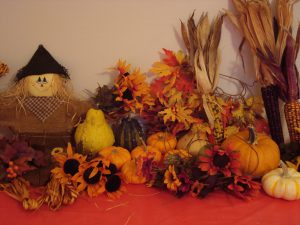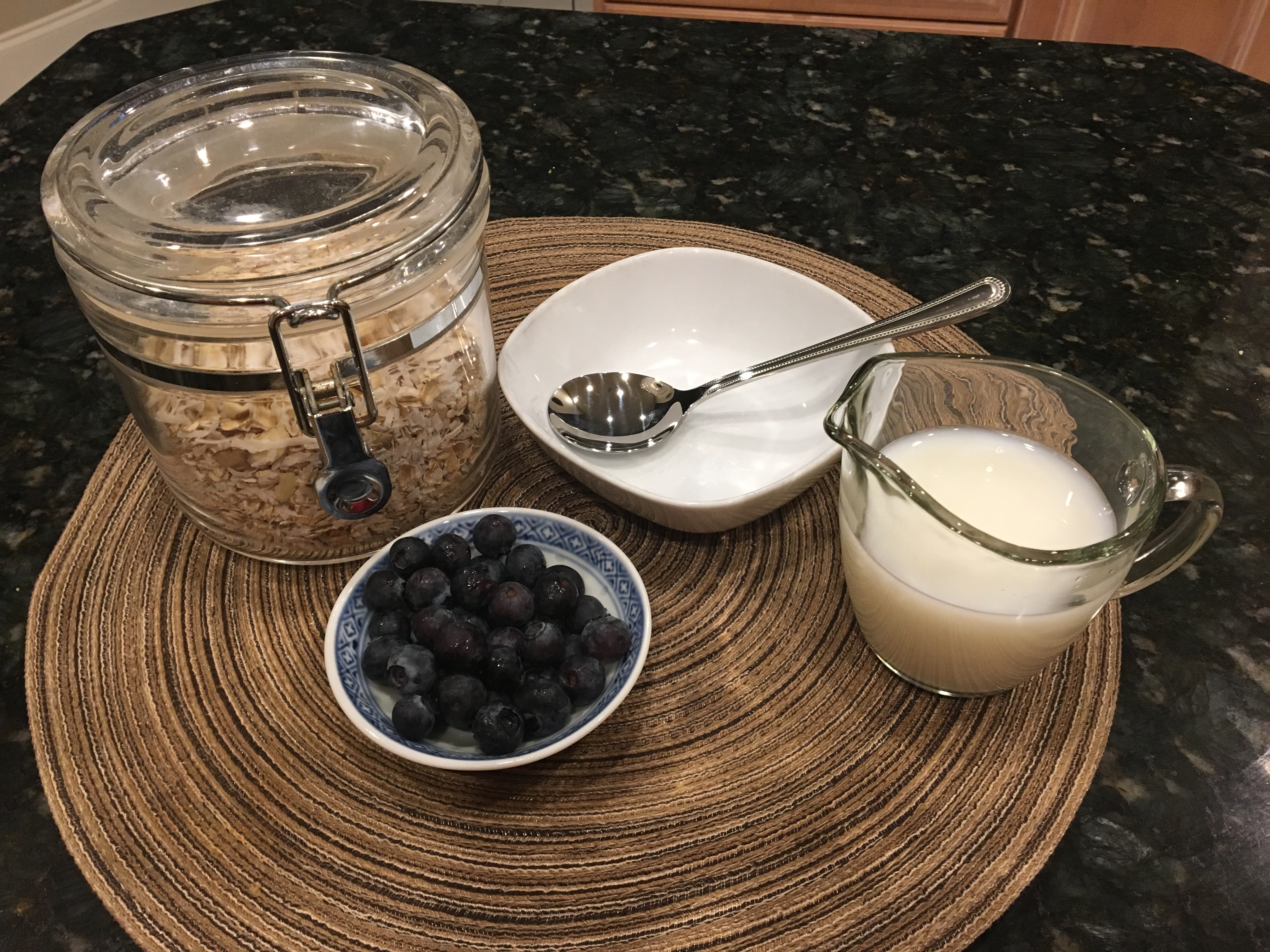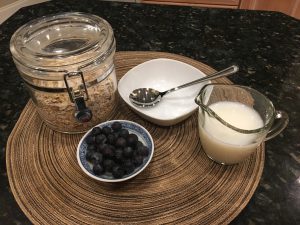
by Angela Hinkle | Nov 26, 2018

FCS Dine In Day December 3
Is your busy, busy life making it difficult to spend time eating a meal at home with your family? Research tells us families are healthier in so many ways when they eat at home together. Maybe these favorite family meals from some of our readers will give you some inspiration.
Italian Night
My mother’s chicken cacciatore. She’s Italian and a great cook. She makes it with boneless chicken breasts, rice, sliced peppers, onions, tomatoes, and of course, garlic. It is so good and probably healthy. But maybe not, since I eat way too much of it. Friends and family come together on “Italian Night” to enjoy this and other Italian specialties. Molto delicioso. Rick W.
My favorite meal was always when my mom made homemade spaghetti sauce for pasta. Wow, that’s good stuff. When I brought my girlfriend home, it became one of her favorite meals too. Thanks mom! Alex H.

Father and son set the dinner table. Photo Source: Wendy Meredith
Home Away from Home Meal
My favorite family meal was pork chops, broccoli, mashed potatoes, rolls and sweet tea, because my son, (my first born), cooked his first meal in his first home away from home at the age of 21 and invited our family to dinner. He was always the one out of five children who liked to have everyone in the family sit at the dining room table together and enjoy a meal as often as possible. Our lives consisted of football, cheerleading, church events, ballet, gymnastics, soccer, school events, jobs, etc. Our family of seven was a very busy family and always running here and there, but somehow due to the persistency of our son, we managed to have one or two meals a week together as a family. I was a very happy and proud mom when I received the invite to have dinner that night. The food was delicious, but the fellowship during “My Favorite Family Meal” was something I will remember and cherish forever. Wendy M.
Let Them Eat Cake or Bread
Celebrations were very special in my family. Every year on my birthday, my grandmother would always cook my favorite food and bake my favorite cake (Red Velvet – Yum). When I was young I always thought it was about the food. But it was about so much more; we learned about manners and etiquette, and family coming together to share old traditions and make new ones. Whenever I see a red velvet cake or smell one baking, it brings back happy memories. I’m transformed back to when I was a 10 year old girl. Dorothy L.
Growing up on a farm in Michigan, I’ve got a lot of good memories involving food! From making butter in a churn, to picking blackberries in the woods for Mom to make pie, to getting ripe tomatoes from the garden for a tasty bacon and tomato sandwich and many more. I consider myself very fortunate to have grown up knowing exactly where our food comes from!
A favorite and happy memory is Mom making bread on cold days, letting the loaves rise by the heat registers, then baking it in the oven. The whole house smelled like delicious bread. Once it was done, Mom would cut it while it was still warm and give us thick slices with warm, melting butter on it! Cheryl V.
December 3rd is Dine In Day. It’s a chance to make a commitment to have a meal at home with family. So, make the decision to eat with your family at home this December 3rd.

FCS Dine In Day

by Angela Hinkle | Nov 21, 2018

FCS Dine In Day December 3
What’s your favorite family meal? Is it an event like a picnic or Super Bowl Party? Is it reoccurring like Wednesday night church dinner? Maybe it’s an annual meal like Thanksgiving. Check out some of these special Thanksgiving meals, then think about a favorite meal for your family to share on Dine In Day.
What about Sweet Potatoes?
I think my favorite holiday meal story is from about 10 years ago when our oldest daughter was away at college. She asked me what we were going to have for Thanksgiving Dinner and as I went through the list she said, “what about sweet potatoes?” to which I answered “but you don’t like sweet potatoes”. Then she said, “No, I don’t, but I they’re supposed to be on the table at Thanksgiving”!
It’s such a tiny thing, but it touched my heart because it meant she had fond memories and that our family holiday dinners meant something to her! PS – now she loves sweet potatoes and serves them to her family all the time! Susan H.
My “Found” Family

Favorite Fall Things
Photo Source:: Angela Hinkle
My favorite family meal of the year is on Thanksgiving, with my “found” family in Bradenton. Especially now that I live in Tallahassee, taking the trip down there to spend a few days with my best friend and her crazy family is definitely a highlight. It’s even more special now since I don’t get to see her every day anymore. Plus? Turkey and deviled eggs! Yummy. Sam K.
Memory We Will Always Cherish
My favorite meal happened 6 years ago during Thanksgiving. It was the first year that I hosted my own Thanksgiving dinner and my husband and I invited everyone we knew- family, friends, coworkers. We had 30 people share their holiday with us and we had so much fun. It was a lot of work and a lot of cooking, but it was so special to us. That day we were able to honor the ones we loved by hosting them and sharing that experience. One day, we will do that again. But for now, it’s a great memory that we will always cherish. Christina W.
Imagining Warm and Cozy
One of my most memorable meals was Thanksgiving when I was in the 11th grade. My family decided to go camping in our pop-up camper for the weekend at a nice campground in central Florida. In keeping with the season, a cold front passed through that weekend, dropping the temperature significantly. Our little camper did not have a heater, so we shivered in our bunks and scurried to the central bathhouse, passing motor homes and travel trailers with condensation on the windows, imagining how warm and cozy their occupants must be. Despite the frigid temperatures, we enjoyed a campground-wide Thanksgiving dinner with all the trimmings in the community room. We made fond memories of the weekend, which we still laugh about, and are thankful for a warm house and the comforts and conveniences of home to enjoy the holiday and everyday meals with family and friends. Judy C.

FCS Dine In Day
December 3rd is Dine In Day. It’s a chance to make a commitment to have a meal at home with family. Research tells us families are healthier in so many ways when they eat at home together. So, make the decision to eat with your family at home this December 3rd. Maybe you can tell us about your favorite family meal or be inspired to make new ones – for Thanksgiving or any time of year.

by Angela Hinkle | Nov 13, 2018

FCS Dine In Day December 3
Uncle Eddie wasn’t actually my uncle. He was my grandfather. But to most everyone in the small town in Connecticut where I spent many summers growing up, he was known as Uncle Eddie.

Edward Scordato aka “Uncle Eddie”
Every Saturday morning, Uncle Eddie got up at some ridiculously early hour and headed for the kitchen. He started a pot of coffee as well as a kettle for tea. He began making pancakes, toast, bacon or sausage, and eggs prepared in a variety of ways. (I think he honed his kitchen/organizational skills as a cook in the Army.)
Friends, neighbors, and relatives from all around came to my grandparents’ dining room and back patio to eat. Just as important, they came to socialize, catch up on how everyone was doing, and hear the latest personal and public events of the week. There was a little gossip and lots of talk of religion and politics. (As a kid, those last two subjects bored me like nothing else could.)
Some folks stayed for 20 minutes. Some stuck around for the whole morning. Uncle Eddie made sure everyone who came got fed. And not just food for their tummies. They were fed with family bonding, love, and a strong sense of belonging (and religion and politics).
Those Saturday morning breakfasts are some of my fondest memories. I honestly don’t remember the taste of the food, but I do remember it just felt good to be with everybody.
December 3rd is Dine In Day.
It’s a chance to make a commitment to have a meal at home with family. Research tells us families are healthier in so many ways when they eat at home together. So, make the decision to eat with your family at home this December 3rd. I’m going to. And it will even be okay if my family starts talking religion and politics.
Oh, and one more thing. Some of our family at UF/IFAS Extension will be sharing their favorite family meals very soon. Maybe you can tell us about yours. Maybe you can be inspired to make new ones.

by Dorothy C. Lee | Jul 30, 2018

Instant Pot settings display. Photo source: Wendy Meredith
An Instant Pot Pressure Cooker is a small electronic multi-cooker appliance that can function as a pressure cooker, slow cooker, rice cooker, steamer, warmer, and more. It is often referred to as an Instant Pot. It is currently the hottest trend in home cooking.
An Instant Pot Cooker can prepare just about any type of food you can imagine. Poultry, beef, and pork recipes, soups, stews, bread, and even desserts.
Considering today’s fast paced lifestyle the Instant Pot is a time saving kitchen helper. Spend a few minutes preparing the recipe ingredients, program the Instant Pot and relax. The Instant Pot cooking method takes the stress out of long cooking times and of meal preparation.
Instant Pot cookers are available in a variety of sizes, styles, and functions. The function of an Instant Pot is based on the model purchased. Many brands are available. Basic functions present in most models consist of slow cooker, pressure canner, steamer, rice cooker, yogurt maker, egg cooker, sauté or browner, and warmer.
When purchasing a multi-cooker consider the usage and quantity of food to be prepared. A 3-quart cooker is just the right size for single servings. Family sizes are available as 6-quart (4-6 servings) or 8 -quart (6-8 servings).
The benefits of an Instant Pot cooker are numerous. No need for constant or frequent stirring, no worry about overcooking or burning, saves energy based on quick cooking times required for recipes and less small kitchen appliances needed for preparation.
Traditionally beef stew and less tender cuts of meat take hours of cooking to render tender. The Instant Pot Cooker dishes up these delicious dishes in under an hour.
Corned Beef Cabbage*
2 pounds corned beef
2 cups chicken broth
2 cups water
3 bay leaves
8 peppercorns
¼ cup apple cider vinegar
8 medium red or white potatoes
8 cups coarsely sliced cabbage
Place beef in cooker. Add stock, water, bay leaves, peppercorns, and vinegar in cooker. Cook for 90 on meat/stew setting. Remove corned beef. Add vegetables; cook on high pressure for 4-5 minutes.
*Follow directions listed on Instant Pot instruction manual for programming cooker.
Instant Pot cooking is easy, economical and quick.
Recipe adapted from Cooks’ Essentials.

by Angela Hinkle | Jul 11, 2018
The pickin’ is plentiful and life is good. Now is the time to take advantage of summer’s bounty. Summer produce is colorful and healthy. It tastes amazing. And right now, it’s everywhere!
Fruits and Veggies in Season
Buying summer produce now means you get fruits and vegetables that taste their best. See Panhandle Produce in Season for what’s in season in the Florida Panhandle. Because this is the easiest time to grow them, they also cost less than at other times of the year. You also may get to learn more about where your food comes from. This is a great time of year to buy local. Speaking of which…

Visit a U-Pick farm for fresh, local produce.
Photo source: Alex Hinkle
U-Pick Farms
When’s the last time you or your kids picked your own food? U-Pick farms are a great way for the whole family to enjoy the outdoors. (Hint: for max comfort and safety, go in the earliest/coolest part of the day.) Picking from a U-Pick helps you get delicious food at a good price. It also helps local businesses thrive. You can meet the local farmers in your area. You usually can get easy, tasty recipe ideas and you can even make new friends. (Working to pick your own food also can make you appreciate how hard it is to have the job of farmer.) To find the closest U-Pick farm in your area, contact your local UF/IFAS Extension Office.
Save Some for the Colder Months
Whether from a U-Pick, farmer’s market, or grocery store, sometimes you just can’t eat all that great produce right now. What to do? Canning or freezing are excellent options. For information on freezing vegetables, see UF IFAS Freezing Vegetables. For fruits like berries, rinse berries well and let them dry on paper towels. Place in plastic zippered bags and freeze. Then just take out the amount you need for blueberry muffins in January – Yum! Or if you live in the South, it’s easy to make cold smoothies in the blender any time of year.

Fresh-picked blueberries are perfect in smoothies and salads.
Photo source: Alex Hinkle
Half MyPlate
The USDA (United States Department of Agriculture) recommends half of your plate be fruits and veggies. Eating in this way gives your body the nutrients it needs to get healthy and stay healthy. Vitamins, minerals, water, and fiber are packed into summer produce. Eat a variety. Try produce in every color, texture, shape, and size. To pack a tasty, healthy wallop for your next meal, make a hot multi-veggie hash alongside a cold refreshing fruit salad. For more ideas on how to add more fruits and veggies into your day, go to Liven Up Your Meals with Fruits and Veggies.
Summer’s Bounty – get it now, enjoy it now!

by Pam Allen | Jun 23, 2018

Start Your Day with Whole Grains Photo Source: Pamela Allen
Don’t let the heat of the summer months deter your path to a healthy diet. Stay focused and take small steps that can make a difference in your health. Breakfast is an important part of a healthy diet. Most of us struggle with what to have on hand that is quick, healthy and gets us on track for our daily intake of healthy food. Start your day right by eating whole grains.
The two types of grains are whole and refined. Grain products include bread, pasta, cereals, rice, corn, oatmeal and barley. The United States Department of Agriculture (USDA MyPlate) recommends that people of all ages get half their grain servings from whole grain sources. How do you determine what is whole grain and what is refined? Read the food’s Nutrition Facts label and know the symbol for whole grains. The “Whole Grain Stamp” is a visual symbol placed on the label that identifies foods approved by the Whole Grains Council. Also look at the list of ingredients and if whole grains are listed first, it is a good source of whole grains. Remember that ingredients are listed from most to least so whole grains should be up in the top part of the ingredient list to be beneficial.
Whole grains provide a good source of fiber and B vitamins. Fiber is the carbohydrate that is non digestible. Fiber keeps our digestive system regular and also can help reduce blood cholesterol. A good goal for women is to consume 25 grams each day while men need 38 grams for their daily intake. For specific recommendations visit https://www.choosemyplate.gov/ . Other sources of fiber include fruits and vegetables, seeds, nuts, and beans.
So now back to breakfast, the first meal of the day. Making your own cereal can be healthy and nutritious. Start with a whole gran like oats. This is the base for homemade granola and also can be cooked as a hot cereal. Try this homemade granola recipe to have available for a whole grain option for breakfast.
Homemade Granola
2 cups of old fashioned whole grain oats
½ cup sliced almonds or other nut like pecans or walnuts
½ cup shredded coconut
2 Tablespoons of Maple Syrup or honey
1 Tablespoon of melted coconut oil to coat the oats (can be melted in the microwave for 10 seconds)
¼ teaspoon of vanilla extract
Optional: ½ cup sunflower seeds, ½ cup of dried fruit
Directions
Preheat the oven to 300º F.
Combine all ingredients in a large bowl. Mix well and toss to coat.
Spread the mixture in a thin layer on a baking sheet lined with parchment paper and bake for 10 – 15 minutes, until very lightly toasted. Allow to completely cool before storing.
Granola can be kept in an airtight container in a cool, dry place for up to 2 weeks.
To use as a morning cereal, scoop ¾ cup and cover with Milk. For added flavor and fiber, add fresh fruit like blueberries or strawberries. May also be eaten as a snack or a topping for yogurt sundaes.
For information about upcoming UF IFAS Extension programs in Okaloosa County, visit our website at:
http://sfyl.ifas.ufl.edu/okaloosa email: pha@ufl.edu or call us at 850-689-5850
“An Equal Opportunity Institution”














